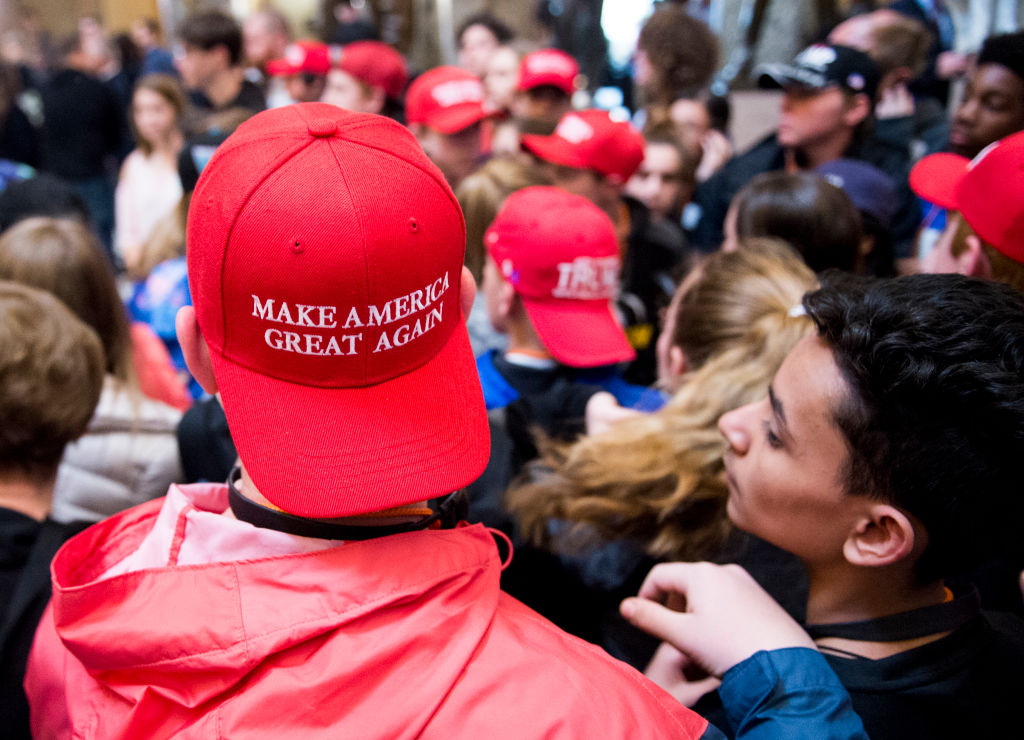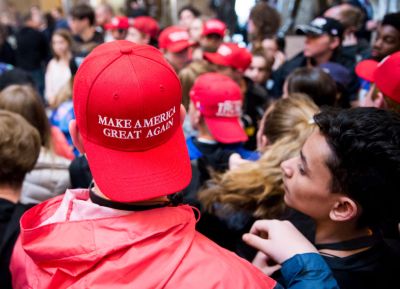An easily observable phenomenon of the Trump era for Washingtonians has been in the semiotics of the bucket hat.
You or your child or another loved one have probably been part of a junior high class trip to the District of Columbia and environs: astronaut ice cream at the Smithsonian Air and Space Museum, some shredded currency at the Bureau of Engraving and Printing, rude jokes about the livestock at Mount Vernon, etc.
We see you all tromping through, bleary-eyed chaperones desperately gripping your overpriced coffees while trying to make sure that the most annoying people to put in large groups in our society—children in seventh and eighth grades—are neither harmed nor cause harm as they are taken to, but then mostly ignore, locations of civic and historical importance. You mess up our traffic patterns, but we forgive you because we know your suffering is real.
One convention of these tour packages is that the youths get a souvenir as part of the hundreds of dollars their families coughed up for them to experience the majesty of our republic by motor coach and shared motel rooms in Crystal City, Virginia. Since 2016, some of those souvenirs have been not the old FBI ball caps that once dominated, but a choice of sweatshirts in cold weather months and, in warmer weather, bucket hats.
At least one tour company offers students a choice of two patterns. One is a pink and blue tie-dye number that declares what is surely not true of either the garment or its wearer: “Authentic Washington.” The other choice is the unmistakable red and white of MAGA.
I have very occasionally seen some young men choose tie-dye, but in eight years of fairly careful observation, have never seen one young woman in the red bucket hat so popular with their male classmates. It’s so common and so striking that I have on a few occasions asked chaperones about the sartorial choices of their hormone-addled charges.
One response that has stayed with me was the mom in Penn Quarter who hooked her thumb at the guys queued up behind her in their best bro slouches and said of their MAGA uniform: “The girls hate it, so they love it.”
This is a little unfair to the boys because, let’s face it, tie-dye is kind of a stretch for the 12-15 male demographic. Unless it’s Nike branded or has a sports team’s logo, the dudelings are mostly going to stick with solids and primary colors over whimsy and kaleidoscopic hues.
The male-female divide, whatever its causes, is unmistakable and may have even contributed to one of the most famous media misses of the era, the red-hatted boys of Covington Catholic in 2019. The boys fit a type familiar to D.C. journos, who jumped to conclusions faster than a civics teacher can smell a blue raspberry vape in the back row at Ford’s Theater.
But we have more to go on than just my field work in the sociology of adolescent tourists.
The Wall Street Journal this week dove into the data on the paper’s most recent presidential polling and found that among the youngest voters, ages 18 to 29, the gender gap is not just large but growing. Merging its surveys from February and July, the Journal found that young men went from a slight Democratic lean to a substantial edge for Republicans.
To consider how profound a change this would be, go back to the 2008 election when, yes, young men were more Republican than young women, but that meant Barack Obama won their votes by 28 points (62-34) instead of the 40 points (69-29) of their female counterparts.
For all the talk about young women and Democrats in the post-Roe world, their support for Democrats looks basically the same compared to when their mothers and aunts were voting for Obama and Hillary Clinton. Young men, though, are different.
We could explain this in lots of ways, including what’s happening with and to young men, who are increasingly falling behind their female counterparts in educational attainment and the job market. If one party stands for the continuation of the current trajectory of female empowerment and one promises disruption, that would logically have some effect.
Certainly, Republicans are hip to the trend. Watching their convention this month it was hard not to get the hint with a display of mucho machismo that would tell every red-hatted eighth grader that this was no party for tie-dyed prisses.
When vice presidential nominee J.D. Vance doubles down on his complaints about childless women, cat loving and otherwise, it’s no doubt a turnoff for female voters. But the young men who feel left behind and who may be struggling to find a mate among career-minded young women probably hear something different.
The wisdom of this strategy looks more dubious when we think about voter propensity. Women reliably outvote men overall, and while the turnout gap seems a little smaller among young voters, it is still present. There were 10 million more female voters than males in 2020.
What has saved Republicans for decades, though, has been that there isn’t so much a partisan “gender gap” as there is a “marriage gap,” even in the Trump era. In 2020, incumbent Donald Trump got just 37 percent of unmarried women, but 52 percent of married women. The shift among men—46 percent among the unmarried, 56 percent among the married—was not that much smaller, but, again, women are the more electorally valuable group overall.
We can’t know how much of the marriage gap is reflective of age (married people as a group are older than unmarried people) and the historical proclivities of older voters for the GOP compared with how much is because voters’ priorities change when they go from being single to starting a family, but it has been an iron law of modern politics. Democrats win the singles, Republicans win the marrieds.
Republicans have for decades been under threat from the increasing age at which Americans marry, now almost four years older on average for women than it was in the late 1990s. More single people and more people waiting longer to have children makes it harder for Republicans to make up for their deficiencies with the folks who Vance says are wrecking society.
We don’t know yet how a new Democratic ticket will affect the youth vote, but the early indications are that presumptive nominee Kamala Harris will do much better than President Joe Biden was doing. A month from now, the new gender gap among 18-29 year olds may have vanished, and young men may have come back to the blue team.
But maybe not. Certainly the Democratic campaign is thinking about it, with the cringey effort to engage “White Dudes for Harris,” who lament a culture that “has positioned white men at the top of a bullying and rigid dominance-based culture of masculinity.”
They’d have an easier time getting a junior high boy to slip on a tie-dye sweatshirt than to get most men to come out against a “culture of masculinity.” But it is a nod to the problem Democrats face with male voters, especially younger ones.
Indeed, Republicans may be able to drive up the score with the bro community as women side increasingly with Harris and the Democrats. The chance to annoy another group, particularly between genders, is a key driver of oppositional definition. If the girls hate the MAGA hats, it makes their appeal even more intense.
But what Trump-Vance Republicanism risks with women of all ages and marital statuses is probably far greater than the rewards the party may obtain among low-propensity, young male voters.
Whatever the consequences, we may be headed for a battle of the sexes in this election that would put junior high to shame.







Please note that we at The Dispatch hold ourselves, our work, and our commenters to a higher standard than other places on the internet. We welcome comments that foster genuine debate or discussion—including comments critical of us or our work—but responses that include ad hominem attacks on fellow Dispatch members or are intended to stoke fear and anger may be moderated.
With your membership, you only have the ability to comment on The Morning Dispatch articles. Consider upgrading to join the conversation everywhere.